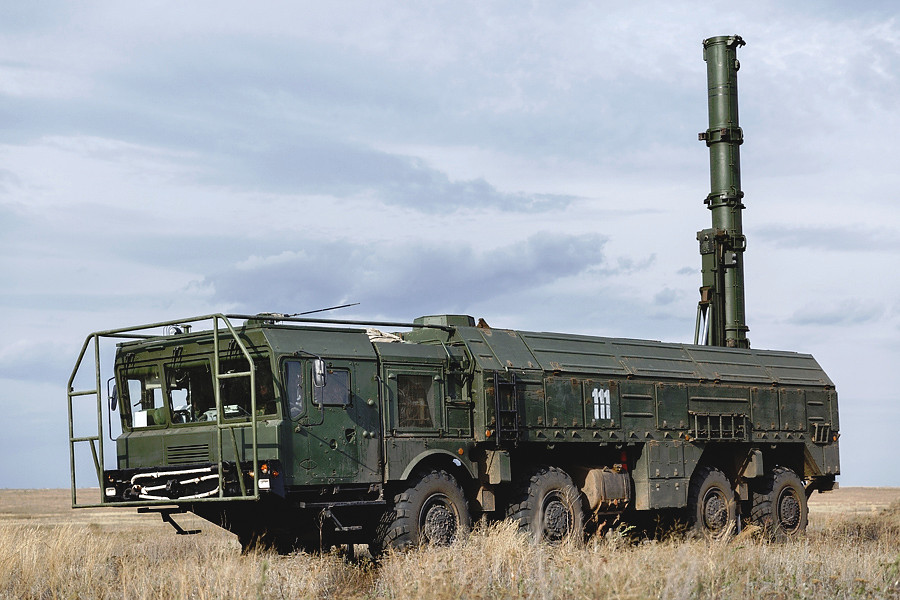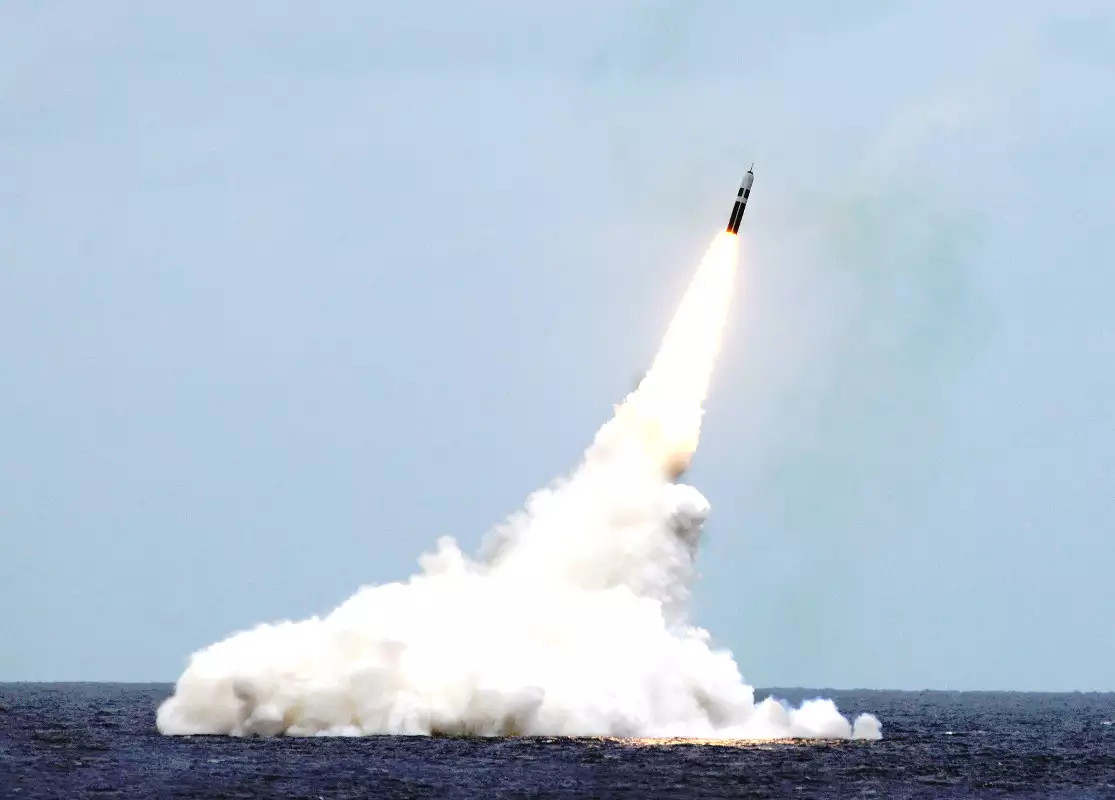The U.S. Permanent Representative to NATO, Kay Bailey Hutchison, has made a series of confusing remarks about Russia’s missiles that violate the Intermediate-Range Nuclear Forces Treaty, or INF, and possible American responses to the deployment of those systems. The ambassador said the United States could pursue options to “take out” those weapons, but did not clearly explain whether this might involve the U.S. military fielding similar designs, greater missile defenses, or even a pre-emptive physical strike or non-kinetic attack. Considering the topic being discussed, the lack of clarity could have dangerous repercussions.
Hutchison made her remarks at a press conference at the NATO headquarters in Belgium ahead of a meeting of top defense officials from the alliance’s member states on Oct. 2, 2018. Before taking up this post, she had served in the Senate from 1993 through 2013 as Republican from Texas and had spent time as a member of the Senate Armed Services Committee. The U.S. government has accused Russia of violating the INF since at least 2013 with the development and subsequent operational deployment of a ground-launched, nuclear-capable land attack cruise missile, which the Russians call the 9M729, the U.S. military designates SSC-8, and the NATO has nicknamed “Screwdriver.”
In 1987, the United States and the Soviet Union signed the INF, which bans the possession of any type of land-based conventional or nuclear-capable missile that has a maximum range of between 310 and 3,420 miles. Russia has never publicly acknowledged the 9M729’s existence and the U.S. government has not released any specific details itself, but the missile reportedly has a range of more than 1,000 miles and possibly more than 1,500 miles. At the time of writing, Russia had not issued a direct response to Hutchinson’s latest comments.
“If Russia continues to say they are not violating when the evidence is clear that they are, then diplomacy needs to be strengthened, and we need to look for other ways to bring Russia to the table on this issue,” Hutchison told the assembled reporters. “The countermeasures would be to take out the missiles that are in development by Russia in violation of the treaty.”

Confusingly, Hutchinson never once mentioned a “cruise missile” as being the weapon the Russians possessed that was in violation of the INF, instead stating twice that the system in question was a “medium-range ballistic missile,” or MRBM. There is no publicly available evidence that Russia is presently working on an MRBM and the U.S. government has never officially accused the Kremlin of pursuing such a weapon in violation of the INF.
Furthermore, the ambassador described the Russian system that has breached the treaty as “in development,” when the United States described the 9M729 as operational in 2017. Experts had questioned whether Russia’s RS-26 intercontinental ballistic missile (ICBM) actually had a range that fell under the terms of the INF, but the U.S. government treated that system as falling under and being in compliance with the separate New Strategic Arms Reduction Treaty (START). That issue is somewhat moot since the Kremlin publicly canceled development of that system earlier in 2018.

There is also the possibility that the ambassador may have been referring to the U.S. government’s understanding of the range of Russia’s Avangard hypersonic boost glide vehicle, which the Kremlin says will enter operational service in 2019. Neither the United States nor Russia has ever publicly described this system as “medium-range” or in potential violation of the INF, though.
Hutchinson did refer to the National Defense Authorization Act for the 2018 Fiscal Year, which ordered the U.S. military to begin examining the potential of fielding its own INF-breaching missile system, as well as dedicated defensive countermeasures to the 9M729. It seems most likely that she was describing a situation in which the United States could deploy these still notional systems to provide a counter to Russia’s land-based cruise missiles and seek to deter Russia from employing them.
The video below includes footage of a test of Russia’s Avangard hypersonic boost glide vehicle on board what may be an RS-26 missile.

“We are not moving in that direction right now,” she noted. “But we are trying to tell Russia, and you know, the United States Congress told Russia last year when they passed the Armed Services Bill about this time last year, that we know they have violated the treaty and we are beginning the research capabilities that are allowed by the treaty to deter a medium-range ballistic missile.”
However, this appears to be the first time a U.S. official has ever suggested that any American development of an INF-breaking system would be specifically to hold Russia’s 9M729 units at risk. In addition, as a result of its latest Nuclear Posture Review, President Donald Trump’s Administration is already looking to develop and field sea-based ballistic and cruise missiles armed with low-yield nuclear warheads, which do not fall under the terms of the INF, ostensibly to deter various Russian developments. The U.S. government has even suggested it might be willing to halt work on those programs in exchange for Russia returning to compliance with the treaty.

Unfortunately, without any real clarification, there remains a possibility that Hutchison could have been referring to other means of neutralizing Russia’s INF-violating systems, or even a layered approach. This could include expanded and improved missile defenses in Europe or a so-called “left-of-launch” option that doesn’t seek to destroy the missiles outright, such as mass cyber attacks or electronic warfare strikes on command and control or even on the weapon’s guidance systems.
There are reports that the United States considered employing these options against North Korea in 2017. In September 2018, the Trump Administration also announced that it had relaxed restrictions on offensive cyber warfare, at least in response to hostile cyber attacks, that the U.S. government had put in place under President Barack Obama.
There is also the potential for the Russians to construe Hutchison’s remarks as a standing threat to launch a pre-emptive conventional or nuclear strike against their assets within their own borders. Similar concerns had emerged when the U.S. military began to more formally lay out its concept for what it referred to as “prompt global strike” under President George W. Bush.
While Hutchison’s comments in context do not appear to actually include such a threat, they are so otherwise confusing as to run the risk of gross misinterpretation. This, in turn, is particularly dangerous given the present state of U.S.-Russian relations and the Kremlin’s own continued assertions that it needs to develop a wide array of new nuclear-capable “super weapons” to ensure that it can deter the United States and NATO.
Russia says the video below shows its nuclear-armed and nuclear-powered Burevestnik cruise missile, one of the Kremlin’s most controversial new strategic weapon developments, which you can read about in more detail here.

Russia’s advanced strategic weapon developments “have shown the whole world that Russia is something to be reckoned with,” Russian Deputy Prime Minister Yuri Borisov said on Oct. 2, 2018. “To put it mildly, the whole world underestimated Russian industry, Russian defense industry, and all our achievements, saying that everything is rusty, their rockets don’t fly.”
As always, it is important to note that the present U.S. military missile defense shield cannot even come close to negating Russia’s existing nuclear deterrent capabilities and looks unlikely to be able to do so at any time in the near future. But even the slightest implication of a pre-emptive American strike would help validate the Kremlin’s rhetoric and its decisions to pursue additional, highly flexible systems such as the 9M729.
Russia itself has already taken an increasingly aggressive stance
toward NATO members and other Western-aligned countries along its borders. While experts debate the exact nature of the policy, the Kremlin has also reportedly established an “escalate-to-deescalate” doctrine that could see the use of small nuclear strikes in an attempt to ward off outside military intervention in areas that Russia sees as within its sphere of influence. Neither Russia nor the United States have a “no first use” policy and both reserve the right to employ nuclear weapons, if appropriate, in response to non-nuclear threats.
Hutchison’s unclear statements also increase the potential for a major miscalculation if Russia believes that the United States is seeking to undermine its weapon development programs. Computer and other system errors in the past have almost sparked apocalyptic nuclear exchanges and there is the distinct possibility that the Kremlin could now worry that any future failure might be the result of an American cyber attack or another form of sabotage – if it doesn’t already. This is something the United States has shown its willingness to do with the infiltration of the Stuxnet computer virus into Iranian nuclear facilities and reported plans for mass cyber attacks if the negotiations surrounding the controversial Iran deal had collapsed.
The entire purpose of agreements such as the INF is to establish confidence-building measures and promote stability. It is right to want the Russians to be fully in compliance with this agreement and to criticize them for undermining its core principles. It is also important, for U.S. officials to be entirely clear about America’s stance and what it is prepared to do in response to the Kremlin’s violations of the treaty.
Hopefully, there will be more clarity coming about exactly what the U.S. government’s policy is and what countermeasures Hutchison was referring that would let the United States “take out” Russia’s INF-violating missiles if it ever comes to that.
Update: 3:30pm EST—
Ambassador Hutchinson has issued a clarification making it clear that she did not intend her remarks to imply the threat of a pre-emptive strike. It still remains unclear, however, exactly what she meant when she said the United States could look into how it might “take out” Russia’s missiles and under what circumstances they would employ those options.
Contact the author: jtrevithickpr@gmail.com
